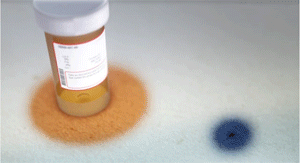Prevention
Antibiotics
Antibiotics can prevent anthrax from developing in people who have been exposed but have not developed symptoms. Ciprofloxacin and doxycycline are two of the antibiotics that could be used to prevent anthrax.
Each of these antibiotics offers the same protection against anthrax. Anthrax spores typically take 1 to 6 days to be activated, but some spores can remain inside the body and take up to 60 days or more before they are activated. Activated spores release toxins—or poisons—that attack the body, causing the person to become sick. That’s why people who have been exposed to anthrax must take antibiotics for 60 days. This will protect them from any anthrax spores in their body when the spores are activated.
How long does it take for anthrax to activate and release toxins?


Antibiotics work in two main ways, by killing the anthrax or by stopping the anthrax from growing. When the anthrax can't grow anymore, it dies.
To learn more, you can watch the full video about anthrax and antibiotics.
Vaccine
While there is a vaccine licensed to prevent anthrax, it is not typically available for the general public. Anthrax Vaccine Adsorbed (AVA) protects against cutaneous and inhalation anthrax, according to limited but well researched evidence. The vaccine is approved by the Food and Drug Administration (FDA) for at-risk adults before exposure to anthrax. The vaccine does not contain any anthrax bacteria and cannot give people anthrax.
Currently, FDA has not approved the vaccine for use after exposure for anyone. However, if there were ever an anthrax emergency, people who are exposed might be given anthrax vaccine to help prevent disease. This would be allowed under a special protocol for use of the vaccine in emergencies.
Anthrax vaccine is routinely used in three groups of adults 18 to 65 years of age who may be at risk of coming in contact with anthrax because of their job:
- Certain laboratory workers who work with anthrax
- Some people who handle animals or animal products, such as some veterinarians
- Some members of the United States military
To build up protection against anthrax, these groups should get 5 shots of anthrax vaccine over 18 months. To stay protected, they should get annual boosters. The shots are injected into the muscle (intramuscular).
Who Should Not Get the Vaccine?
Certain people shouldn’t get the anthrax vaccine in routine situations.
- Anyone who has had a serious allergic reaction to a previous dose of anthrax vaccine should not get another dose.
- Anyone who has a severe allergy to any component of the anthrax vaccine should not get a dose. Anyone with severe allergies, including allergy to latex, should tell their doctor.
- For anyone with a moderate or severe illness, their doctor might ask them to wait until they recover to get the vaccine. People with mild illness can usually be vaccinated.
- Pregnant women should not get the vaccine.
In certain situations, such as a bioterrorist attack involving anthrax, anthrax vaccine might be recommended to prevent anthrax in people after they have been exposed.
If this were to happen, people who were exposed would get 3 shots of anthrax vaccine over 4 weeks plus a 60-day course of antibiotics to prevent disease.
During an emergency, the only people who should not get the vaccine after exposure are those who have had a serious allergic reaction to a previous dose of anthrax vaccine.
Prevention and Treatment Recommendations
Clinical Framework and Medical Countermeasure Use During an Anthrax Mass-Casualty Incident: CDC Recommendations (2015)
Antimicrobial Treatment for Systemic Anthrax: Analysis of Cases from 1945 to 2014 Identified Through a Systematic Literature Review (2015)
Antitoxin Treatment of Inhalation Anthrax: A Systematic Review (2015)
National Notifiable Diseases Surveillance System: Case Definitions (2010)
Prevention and Treatment of Anthrax in Adults (2014): Results of CDC Expert Panels
EID Journal (2014): Special Considerations for Pregnant and Postpartum Women
Pediatric Anthrax Management (2014): Executive Summary Clinical Report
CDC Guidance (2013): Anthrax Vaccine Adsorbed (AVA) Post-Exposure Prioritization
For More Information
- Visit the U.S. Food and Drug Administration website.
- See the Anthrax Vaccine Adsorbed Vaccine Information Statement.
- See the vaccine package insert [PDF – 165 KB/16 pages].
- If you are in the U.S. military, visit the U.S. Department of Defense website or call 1-877-438-8222.
- Contact your local or state health department.
- Page last reviewed: January 14, 2016
- Page last updated: January 14, 2016
- Content source:


 ShareCompartir
ShareCompartir